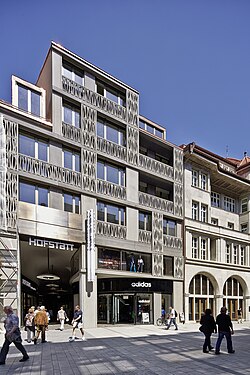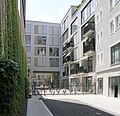Hofstatt (shopping arcade)

|
||
| Exterior view of Hofstatt | ||
| Basic data | ||
| Location: | Munich old town | |
| Opening: | 2013 | |
| Sales area : | 15,500 m² | |
| Owner : | LBBW Immobilien GmbH | |
| Website: | Internet presence of the Hofstatt shopping arcade | |
| Transport links | ||
| Stops: | Marienplatz and Sendlinger Tor | |
| S-Bahn : |
|
|
| Subway : |
|
|
| Technical specifications | ||
| Architect : | Marcel Meili | |
The Hofstatt is a shopping arcade opened in 2013 in Munich's old town . The core of the building is the former site of the Süddeutscher Verlag , whose historic editorial building by architect Max Littmann on Sendlinger Strasse and its brick-built printing facility are part of the project.
Almost the entire street block between Sendlinger Strasse, Färbergraben, Hotterstrasse and Hackenstrasse was developed under the name Hofstatt, which comes from an impasse. In addition to the commercial buildings, it also includes residential developments on Hotterstrasse and Hackenstrasse and is grouped around several inner courtyards.
Shopping arcade
The Hofstatt opened in April 2013 on an area between Sendlinger Strasse , Hackenstrasse and Färbergraben. It comprises 15,500 m² of fashion and furniture stores as well as gastronomic businesses and 18,000 m² of office space and 69 apartments. Similar to other shopping malls (for example, Fünf Höfe , Stachus -Passage or Kaufingertor -Passage) it is located near central Munich public transport hubs between Marienplatz and Sendlinger Tor .
architecture
The three-armed shopping arcade connects new buildings by Marcel Meili, which were completed in 2013, with some of the old buildings that are listed as monuments . The facade designed by Max Littmann in 1905/06 was integrated into the building, which was used as the editorial building for the Süddeutsche Zeitung between 1945 and 2008 and was then completely gutted. A central point is the “Lichthof”, which owes its name to a glass dome that already covered the printing house of the Süddeutsche Zeitung. Shop windows made of curved panes of glass can be found along the curved passageways .
The previously inaccessible inner courtyards of the area have been opened to the public since the reopening.
Offices have been set up on the upper floors of the commercial buildings. With the shopping arcade, apartments were also built on the property, but in separate buildings facing Hofstatt Street and the corner of Färbergraben.
Economic
The building was built by the real estate subsidiary of Landesbank Baden-Württemberg and the American real estate company Hines Interests Limited Partnership and, after opening at the end of 2013, was acquired by Quantum Immobilien AG , which has been marketing it since then and acting as the owner's representative. The purchase price is around 400 million euros.
The originally planned completion date at the end of 2010 could not be met due to the removal of contaminated sites (backlogs from the former Süddeutsche Zeitung print shop ) and financing issues.
The anchor tenant is Abercrombie & Fitch , which operates one of eight of its German branches at Sendlinger Strasse 8.
See also
Web links
- Hofstatt on muenchenwiki.de (information on the history of the site)
- First construction site, then luxury. Süddeutsche Zeitung, February 1, 2012, accessed April 10, 2016 . (Photo gallery of the building of the Hofstatt)
Individual evidence
- ^ Hofstatt: memorial plus new building. muenchenarchitektur.com, 2013, accessed April 10, 2016 .
- ↑ Real estate in Munich - the most spectacular deals. Süddeutsche Zeitung, May 26, 2014
- ↑ Matthias Kristlbauer: Problems with construction: Hofstatt not finished before 2013. Münchner Merkur, April 27, 2010, accessed April 10, 2016 .
Coordinates: 48 ° 8 ′ 10.9 ″ N , 11 ° 34 ′ 17 ″ E




